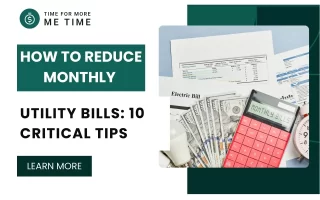Saving money every day might seem like a daunting task, especially when bills pile up and unexpected expenses pop up. But what if you could make small, manageable changes to your daily habits that actually add up over time?
That’s the beauty of saving money every day – it’s not about drastic measures but about making mindful choices that build a stronger financial foundation for your savings goal.
In this guide, we’ll cover practical tips to show you just how doable (and even enjoyable) saving money every day can be, so we can achieve having an emergency fund that can prevent us from relying on a personal loan.
Top 5 Easy Ways to Start Saving Money Every Day
First off, you’re not alone in wanting to get a better handle on your finances, pay off credit card debt or a student loan. According to a recent survey, 70% of Americans feel stressed about their personal finances.
The solution to that is to start knowing how to save money each day. Saving money every day can be your ticket to not just financial stability but peace of mind, too.
1. Track Your Spending and Make a Budget
Before going to other ways of saving money every day, you need to learn the basics of tracking your spending. This foundation can help you save money much more quickly.
Track Your Spending
You know the old saying: “You can’t manage what you don’t measure.” That’s definitely true for your money. Before you can achieve your savings goals, you need to figure out where your money actually goes.
A clear picture of your finances helps you understand your spending habits, identify areas for improvement, and make informed financial decisions.
Don’t worry; it’s easier than you think.
You can start tracking your spending with a simple notebook. But you can also use apps or spreadsheets if you prefer.
What’s important is to utilize these tools to categorize your expenses, like groceries, transportation, and entertainment, making it easier to know your living expenses.
Once you have a good understanding of your spending habits, you can set spending limits for each category.
Create a Budget
Having insight into your spending is super valuable when you create a budget.
A budget is not meant to restrict you; think of it as a roadmap to get you closer to your financial goals. First, decide on your financial goals: What are your savings goals for—short-term goals (e.g., a vacation, a new phone) or long-term goals (e.g., retirement, a down payment on a house)?
Then, choose from the different budgeting methods.
There’s the 50/30/20 method, which allocates 50% of your income to necessities, 30% to “wants” or desires, and 20% to savings and debt repayment.
There’s the zero-based budget, which requires you to account for every dollar you earn by assigning it to different categories until you have zero dollars left unassigned.
Finding the right budgeting method that fits your personality is vital to making it sustainable. The best budget is one you stick with, so remember to check in and adjust as your circumstances change.
2. Cut Back, Spend Smarter
Tired of watching your money disappear faster than you earn it? You work hard for your cash, and you don’t want to just let it vanish.
This is how you make it last: Control your spending.
It doesn’t mean you can’t have fun, but you need a plan. Think of it like this: You wouldn’t drive across the country without a map, right?
That’s where tracking and budgeting come in. After you do what we’ve discussed above, you can start making changes.
Cutting Back on Unwanted Expenses
Do you really need that daily latte? Could you pack your lunch a few times a week instead of eating out? Even small changes can make a big difference over time. Remember, it’s about saving money every day, not just once in a while.
Subscriptions – how many streaming services do you really need? Do you use that gym membership or any service that’s automatically charging your card? Are you constantly signing up for trials and then forgetting to cancel before they charge you?
Take control and unsubscribe to free up cash flow. Saving money every day is often about finding contentment in the simple things.
And those impulse buys—that tempting gadget at the checkout or a sale item that catches your eye? If unchecked, these small splurges contribute to your spending without providing true satisfaction.
Look around your home. Is unused gym equipment gathering dust?
Now that you’re tracking, let’s talk about cutting back. This doesn’t mean living like a hermit. It just means being smart about your spending. For example:
Do you really use all those streaming services? Maybe pick one or two and cut the rest.
Try buying generic brands at the grocery store. You’ll be surprised how much you can save.
Look for free or low-cost entertainment options like going to the park or having a movie night at home.
See? It’s not so bad! By making a few small changes to your spending habits, you’ll be able to beef up your savings account or emergency fund.
Becoming a Shopping Genius
For most people, groceries are the biggest expense after housing.
Creating a weekly meal plan helps you only buy what you need, so less food ends up spoiling in the back of the refrigerator. What’s more? Coupons are your best friends—whether they’re Sunday newspaper clippings, digital coupons, or rewards points.
Cash-back apps let you earn money back. Try Ibotta or Fetch Rewards, where you can search for online promo codes before completing online purchases.
Next, clothes and accessories: do you really need the latest fashion trend, or would some great finds from thrift stores work? Websites like Poshmark or The RealReal offer second-hand clothing from top brands.
Plus, by extending the lifespan of clothes, you are supporting sustainability.
Moreover, when it comes to online shopping – use those comparison websites. Do a quick Google search; there are a ton of options that let you find the best deal before committing to a purchase.
3. Save on Utilities, Housing, and Transportation
One of the simple ways in saving money every day is to conserve on utilities, housing, and transportation. And how to do this?
Turn Down Your Bills, Not Your Lifestyle
Think those utilities are fixed costs? Think again. There are frugal lifestyle ideas that can help you with these, and some of them I will discuss below.
Even tiny changes can lower your bills. Make a habit of turning off lights when you leave a room. Unplug electronic devices that are not in use as even in “standby,” they consume a tiny bit of power – these “phantom loads” really add up.
Switch to energy-efficient LED light bulbs, which use less electricity. They’re more expensive upfront, but the savings on your electricity bills are definitely worth it.
Water conservation is another way to reduce your utility bill.
Fix any leaking faucets. Small leaks waste a huge amount of water. You can also use water-saving showerheads to reduce water consumption.
Now, onto heating and cooling.
Programmable thermostats help regulate temperature according to your schedule, so you won’t have to heat or cool an empty house.
And did you know that proper insulation is one of the easiest ways to lower energy costs? By preventing heat loss in the winter and cool air loss in summer, you reduce reliance on heating or cooling systems.
Transportation Savings
Ditching that car even a couple of times a week helps the planet and your wallet.
Depending on your location, public transportation, like buses and trains, can get you to your destination at a fraction of the cost of using your car. Plus, there are bonus savings—no gas costs, parking fees, or car maintenance costs.
You also get to read or listen to podcasts while commuting – making those commutes productive.
Do you have a friend or a neighbor who travels a similar route for work? Maybe start a carpool system to split costs and build community, too.
Or better yet, go with being physically active. Walking or biking not only improves your health but also connects you with your surroundings in a way driving simply doesn’t allow. All of this contributes to reducing your carbon footprint and helping you get closer to your saving goal efforts when broke.
4. Go DIY
Trying DIY is also a good way to help you in saving money every day. Instead of using your credit cards or online banking when you do things, check your resources and be creative.
Try Homemade Help
You may be surprised to learn cooking is one of the biggest budget-busters. Try a “no-spend challenge” – a week dedicated to only eating meals you cook at home.
Explore simple, delicious recipes online using affordable ingredients. Once you get confident with the basics, explore cooking in bulk for freezing. This allows you to have “pre-made meals” for busy nights, eliminating the temptation to order with your credit card or debit card.
But if you use your credit card to buy stuff, ensure that you get credit card rewards. Again, use your credit cards to buy essential things and not spend money with the sky’s the limit.
Moreover, consider basic home repairs – fix that leaky faucet instead of calling a plumber.
YouTube is full of helpful DIY repair tutorials for replacing a light fixture or unclogging a drain—small changes add up to big savings.
Instead of rushing out to buy generic gifts with your credit cards, why not create something unique? Baking a cake, knitting a scarf, framing a photo, or upcycling a vintage treasure shows thoughtfulness while costing less.
Practice Leisure and Entertainment on a Budget
How often do you really watch every show on all of your paid streaming services connected to your online banking or mobile banking? Check if you’re indeed using all of them.
If you do, negotiate a better price, or maybe you only need one for everyone in your family.
Better yet, embrace old-school fun – how about hosting board game nights, potlucks, or even picnics? Game night is fun, budget-friendly, and sparks connection.
You can also visit public libraries, which offer an absolute treasure trove of resources – books, movies, magazines – all for free. Local parks and hiking trails, free concerts, or even street fairs provide fun and help you discover hidden gems within your own community.
Doing money-saving methods every day becomes less about restriction and more about uncovering new passions.
5. Be Smarter About Banking and Investing
You don’t need a fortune to invest – it’s about starting small and consistently building.
Have a hard time doing so? Take advantage of automated savings features, whether via online banking or through your investment accounts. This “set it and forget it” approach helps you effortlessly build your savings account over time.
Look into high-yield savings accounts, which offer a better interest rate than a standard savings account, so that you can achieve your savings goal much faster.
Think of starting a simple investment strategy—open a brokerage account. Try a low-risk, long-term investment strategy, even with a few dollars each month.
The idea here is to use the power of compounding. Instead of performing a direct deposit to your bank, you can set up a recurring automatic transfer to your savings or investments account. You can start with this savings plan for as low as $5 to $10 per week.
Sometimes, getting back on track financially can be emotionally taxing, especially with substantial debt looming. I experienced that, too, but if I was able to pay my student loans and credit card debt, you can as well.
It can help to reach out to a certified financial advisor or money manager for guidance and support. While we don’t promote specific providers, know that these advisors are available and offer advice tailored to your unique financial situation and goals.
Saving money every day becomes less about depriving yourself and more about creating a path toward a more fulfilling life – financially, emotionally, and maybe even creatively.
FAQs
How can I save $1000 in 30 days?
While saving $1000 in 30 days might seem ambitious, it’s possible. Combine intense short-term cost-cutting measures with boosting your income.
How do I save money daily?
Saving money every day is about incorporating simple mindful choices into your routine – carrying a reusable water bottle to avoid purchasing drinks, packing lunches, and utilizing your local library. This creates a mindset that shifts your spending habits from unconscious consumption toward deliberate savings.
What is the 52-week rule?
The 52-week savings rule is a simple, effective savings challenge. You start by saving $1 in week 1, and $2 in week 2, and continue increasing your weekly savings by $1 each week. This means you’d save $52 by week 52.
What is the $3 52-week money challenge?
Though it may not be like saving money every day since it’s a weekly saving challenge, this is similar to the 52-week savings rule. The $3 52-week money challenge allows you more flexibility to ramp up your savings when you feel ready. Download a free tracker from a reputable source, and decide on an amount – whether it’s $3 or a higher number – $5, $10 – based on your income.
Conclusion
Remember, saving money every day is a journey, not a destination. It’s about progress over perfection, creating small, manageable habits and wins to celebrate. Over time, these mindful practices transform from tasks into ingrained habits.
Again, saving money every day isn’t about deprivation – it’s about having the freedom to achieve your dreams. Whether that is to start a small business or pay off that student loan, you can eventually achieve it by having a savings goal for each objective.
Saving money every day can bring the financial security and peace of mind we all strive for. It can help unlock the joy of a mindful, meaningful, and intentional life instead of relying on our credit cards or personal loans.






